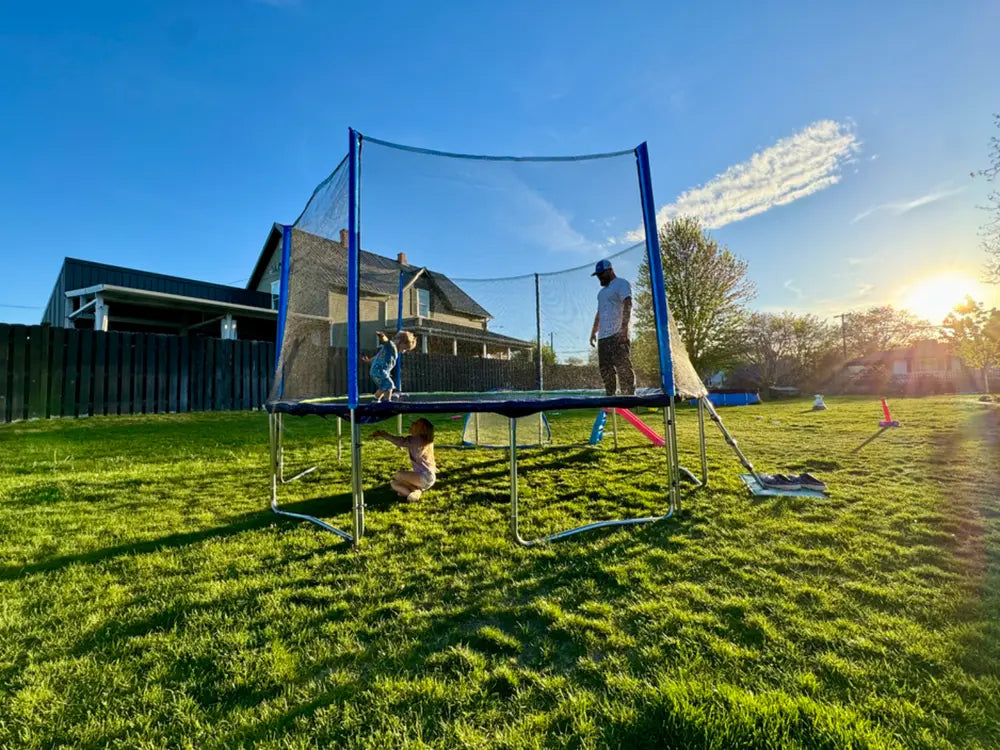Jumping on a trampoline is a childhood rite of passage—a whirlwind of laughter, flips, and mid-air acrobatics. But behind the fun lies a sobering truth: trampolines send over 100,000 kids to emergency rooms annually in the U.S. (data from the National Electronic Injury Surveillance System). While these backyard staples encourage active play, prioritizing trampoline safety tips is non-negotiable to prevent trampoline injuries and ensure kids bounce responsibly. This guide breaks down actionable strategies, from choosing the safest equipment to fostering kids' trampoline safety habits that protect your family.
Choosing the Right Trampoline for Safety
Not all trampolines are created equal, and investing in a model with robust safety features is a wise decision. Think of it as an investment in your child's well-being, and actively seek out the best trampoline safety features for families.
Size and Shape Matter
The size of the trampoline should be appropriate for the age and number of children who will be using it. Smaller trampolines are generally safer for younger children, while larger trampolines can accommodate older kids and teens, but with increased risk if safety protocols aren't in place. The key is to understand how to prevent trampoline injuries in kids, and shape is a factor. While round trampolines are the most common, rectangular trampolines offer a different bounce experience and might require more space. Choose the shape that best suits your backyard and your children's needs, always prioritizing space and safety.
Essential Safety Features
Enclosure Nets
A properly installed and maintained enclosure net is arguably the most important safety feature. It prevents jumpers from falling off the trampoline and onto the hard ground. Ensure the net is securely attached to the trampoline frame and free from tears or damage. These nets are among the best trampoline safety features for families.
Padding
Thick, impact-absorbing padding should cover the springs, frame, and any other hard surfaces around the trampoline. This padding helps cushion falls and reduces the severity of injuries. Inspect the padding regularly for wear and tear and replace it for trampoline accident prevention.
Spring Design
The design of the springs also contributes to safe trampoline jumping for children. Look for trampolines with covered or enclosed springs, which minimize the risk of fingers or toes getting caught. Some trampolines use bungees instead of springs, which can offer a softer and quieter bounce, along with improved safety.
Weight Limits
Adhering to the manufacturer's weight limit is crucial to prevent trampoline injuries. Exceeding the weight limit can cause the trampoline to become unstable and increase the risk of accidents. Be aware that the weight limit isn't just about the trampoline collapsing; it also affects the bounce and the control that jumpers own. Strict adherence to weight limits is part of safe trampoline jumping for children.
Certifications and Standards
Look for trampolines that meet relevant safety certifications, such as those from the American Society for Testing and Materials (ASTM). Choosing a certified trampoline provides added assurance of kids' trampoline safety. It demonstrates that the manufacturer has taken steps to ensure the product is designed and manufactured with safety in mind.
Setting Up a Safe Trampoline Area
A safe environment around the trampoline is highly recommended to prevent trampoline injuries. When it is properly maintained, it can exert considerable influence in the prevention of trampoline accidents.
Location
Select an open, flat, smooth surface free of stones, roots, and other obstacles. Uneven ground can destabilize the trampoline and result in falls. There must be plenty of open, unobstructed clear space surrounding the trampoline at all times, at least a couple of feet in each direction. In this open area, there should be no trees, fences, power lines, etc. The trampoline should ideally be placed on a cushioned, impact-absorbing surface such as grass, mulch, or trampoline safety mats, which is a key element for trampoline accident prevention.

Regular Inspections and Maintenance
Ensure that the enclosure net is in good order (i.e., no holes or scratches) and repair or replace it as soon as possible. Check the padding for degradation and validate that it is secured with regard to the structure. Inspect the frame to look for cracks or bowing, and repair in the instance of a crack or bowing. Tighten all bolts and screws on a trampoline systematically to keep it firm and safe. These are all essential trampoline safety tips since maintenance plays a crucial role in the subsequent prevention of trampoline injury.
Environmental Factors
Avoid using the trampoline in wet or windy conditions because wet surfaces are slippery and increase the risk of falls. With high winds, it is possible to impart to the trampoline the characteristics of being unpredictable and uncontrollable. Understanding trampoline injury statistics and prevention involves knowing the risks associated with various weather conditions. Do not allow trampoline use without proper attire in very hot or very cold temperatures due to the potential effect of the temperature change on the materials and the potential cause of accidental injury.
Safe Jumping Practices for Kids
There are guidelines for safe trampoline use to prevent trampoline injuries in kids.
One Jumper at a Time
Multiple jumpers increase collision risks. According to the American Academy of Orthopaedic Surgeons, more than half of trampoline traumas involve more than one user. Enforcing a “one-at-a-time” rule is a cornerstone of kids' trampoline safety.
Supervision is Non-Negotiable
Never leave kids unsupervised—even teens. Any play session must be supervised by an adult who can implement the rules and must deal with accidents. This directly relates to how to prevent trampoline injuries in kids.
Age-Appropriate Play
It is, in general, too hazardous to allow children to use trampolines prior to the age of 6, and safety professionals discourage this activity. For older children, limit sessions to a 20-minute duration to prevent fatigue-related damage. Understanding trampoline injury statistics and prevention is key to making informed decisions about age limits.
Mitigating Risk and Liability Following an Incident
Despite all precautions, accidents can still happen. Knowing the proper steps after an incident is a critical aspect of all trampoline safety tips. For minor injuries (e.g., sprains, strains), it is recommended to apply ice, as well as to elevate the injured area. Document the injury along with the date, time, and description. Such data may be of interest if and when a medical or insurance claim is submitted.
Conclusion
If you take the above precautions and keep a watchful eye, you can guarantee the safe and joyous play of your children on a trampoline. Remember, the best trampoline safety features for families are only as effective as the rules and supervision that accompany them. Prioritizing kids' trampoline safety is an ongoing commitment.




